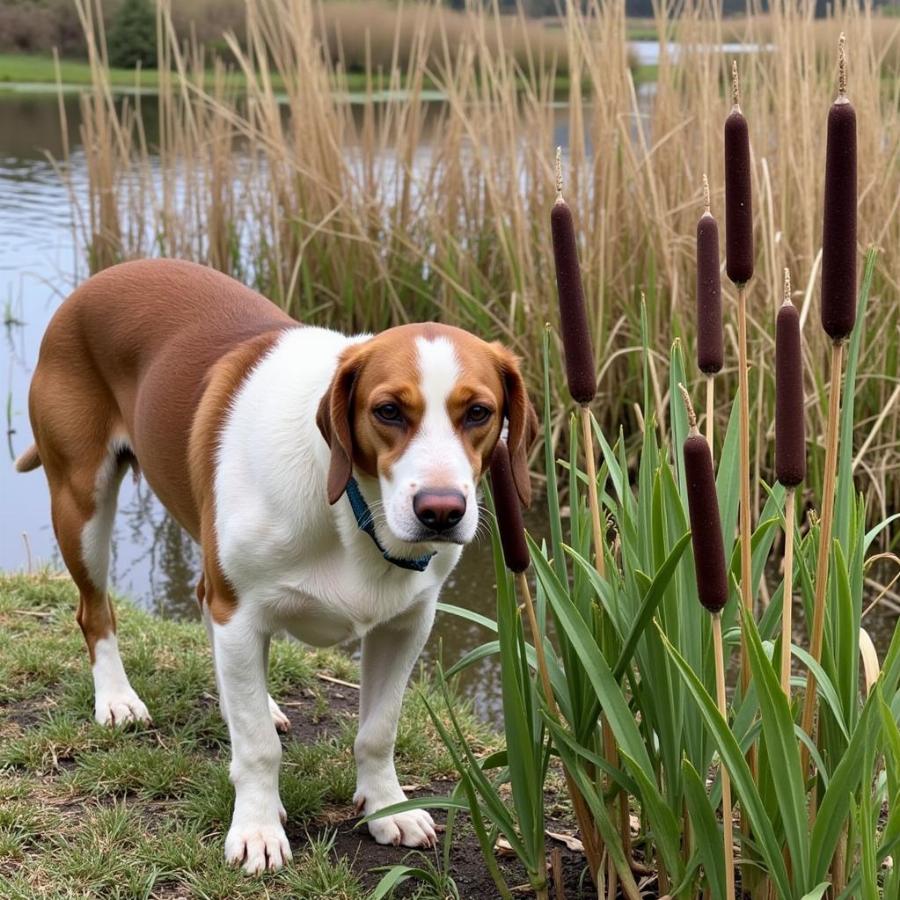The term “corn dog plant” is often used colloquially to refer to the common cattail (Typha latifolia), whose brown, cylindrical flower spike resembles a corn dog. While these plants might pique your dog’s curiosity, understanding their potential risks and how to manage them in a dog-friendly environment is crucial. This article will explore the relationship between dogs and “corn dog plants,” focusing on safety and responsible pet ownership.
Are cattails poisonous to dogs? Generally, cattails themselves aren’t considered highly toxic to dogs. However, ingesting large quantities can cause gastrointestinal upset, such as vomiting and diarrhea. The biggest concern lies in the potential for obstruction if your dog swallows the fluffy seed heads. Additionally, the leaves can be irritating to a dog’s mouth and throat. So, while a curious nibble might not be a major issue, it’s best to discourage your dog from consuming any part of the plant.
Understanding the “Corn Dog Plant” and its Risks
Let’s delve deeper into what exactly a “corn dog plant” is and why it might pose a risk to your furry friend. The term is a nickname for cattails, tall wetland plants recognizable by their unique brown, fuzzy spikes. While cattails are a natural part of many ecosystems and even have some edible uses for humans, they present certain hazards for dogs.
What are the specific risks of cattails for dogs? As mentioned, the fibrous nature of the plant can be problematic. The leaves can cause irritation to the mouth, throat, and digestive system. More importantly, the seed heads, when ingested, can form a blockage in the esophagus or intestines, requiring veterinary intervention.
 Dog near a cattail plant
Dog near a cattail plant
Creating a Dog-Safe Environment Around Cattails
If you live near an area with cattails or have them in your own garden, you can take steps to minimize the risk to your dog. Proper training and management are key.
How can I train my dog to stay away from cattails? Start by teaching a strong “leave it” command. This command is invaluable for preventing your dog from interacting with potentially harmful plants and objects. Positive reinforcement, using treats and praise, is the most effective method. Consistency is also crucial – practice the “leave it” command regularly, especially in areas where cattails are present. A well-trained dog should be able to resist the temptation to investigate or consume these plants.
plant that looks like corn dog
Alternative Landscaping Options for Dog Owners
If you’re concerned about cattails, consider dog-friendly landscaping alternatives. Many beautiful and safe plants can enhance your garden without posing a threat to your canine companion.
What are some safe plant alternatives to cattails? Sunflowers, zinnias, and snapdragons are colorful and non-toxic options. For ground cover, consider clover or creeping thyme, which are generally safe for dogs. Remember to research any new plant before introducing it to your garden to ensure it’s dog-friendly.
Recognizing Signs of Plant Ingestion and Seeking Veterinary Care
Even with preventative measures, accidents can happen. Knowing the signs of plant ingestion and when to seek veterinary care is essential.
What should I do if my dog eats a cattail? Watch for symptoms like vomiting, diarrhea, loss of appetite, or lethargy. If your dog exhibits any of these signs, contact your veterinarian immediately. Early intervention can prevent serious complications.
Preventing Cattail Growth
If you want to reduce or eliminate cattails in your yard, there are safe and effective methods you can use.
How can I safely remove cattails? Physical removal, such as cutting or digging them up, can be effective. Ensure you remove the entire root system to prevent regrowth. For larger infestations, you may want to consider safe herbicides for dogs as an option, but always ensure they are pet-friendly and used according to the instructions. Consult a professional landscaper for advice on the best approach.
Conclusion
While the “corn dog plant,” or cattail, may not be inherently poisonous, it can present several risks to your canine companion. Understanding these risks, implementing preventative measures, and recognizing the signs of plant ingestion are crucial for responsible dog ownership. By creating a safe environment and providing proper training, you can ensure your dog enjoys a healthy and happy life, free from the potential dangers posed by these intriguing yet potentially hazardous plants. Remember, a proactive approach is always the best way to protect your furry friend.
FAQ
-
Are all parts of the cattail plant dangerous for dogs? While all parts can cause issues, the seed heads pose the greatest risk due to the potential for intestinal blockage.
-
What are the first signs that my dog might have ingested a cattail? Look for vomiting, diarrhea, loss of appetite, or unusual lethargy.
-
Are there any home remedies for cattail ingestion in dogs? No. If you suspect your dog has ingested a cattail, contact your veterinarian immediately.
-
Can I use any herbicide to remove cattails? No, use only pet-friendly herbicides and follow the instructions carefully.
-
What are some good alternatives to grass for a dog-friendly lawn? Clover and creeping thyme are good options, but research any plant before introducing it to your yard.
-
How can I discourage my dog from eating plants in general? Consistent training, using commands like “leave it,” is the most effective approach.
-
What are other common plants that are toxic to dogs? Some common toxic plants include lilies, tulips, and azaleas.
See more related articles: memorial stones for dogs, nutra dog food, why does my dog nibble on my other dog
Beaut Dogs is your trusted resource for all things canine, offering comprehensive and reliable information on dog breeds, care, and well-being. For personalized advice and assistance, please contact us at Email: [email protected]. We’re dedicated to helping you provide the best possible care for your beloved companion. Visit us at https://beautdogs.com to explore a world of information and resources for dog lovers.